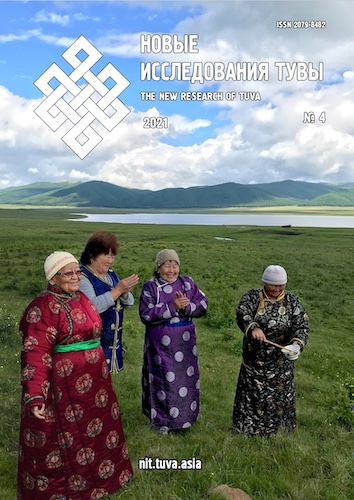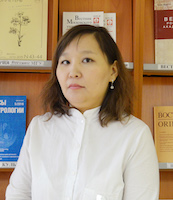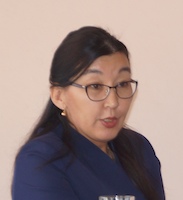A Buddhist Ritual of Big Dipper veneration (based on the Tibetan manuscript from Tuvan archives)
DOI:
https://doi.org/10.25178/nit.2021.4.12Keywords:
Buddhist ritual; tshe thar; seter; Ursa Major veneration; Mongolian Buddhism; TuvaAbstract
The article introduces the text of a Tibetan manuscript “Sme bdun skar ma'i lug gi tshe thar zhes bya ba bzhugs so” (Tshe-thar (freeing life) of the ewe devoted to Big Dipper) preserved in the Tuva Institute of Humanitarian and Applied Socio-Economic Research under the Government of the Republic of Tyva. It contains valuable data on the Buddhist tshe-thar ritual devoted to the Ursa Major constellation.
This manuscript probably refers to Mongolian popular Buddhism, since similar texts in Tibetan have been found only in the National Library of Mongolia. The analysis of Tibetan tshe-thar ritual and Mongolian seter carried out in the publication leads us to propose that these rituals in the tradition of Mongolian Buddhism are identical. Ethnographic data on the seter ritual devoted to the Big Dipper show the existence of special texts read by Buddhist lamas during ritual. The manuscript from the Institute’s Tuvan collection could also refer to this group of texts.
The text is poetic, containing an appeal to the constellation deities named as Seven Tathagatas, offering to them a white ewe adorned in a special way, and final requests for various benefits, liberation from obstacles, diseases and harmful influences.
References
Bakaeva, E. P. (2020a) Pochitanie Bol'shoi Medveditsy v srede oiratov i kalmykov: drevneishie predstavlenia i buddiiskie naplastovania. Chast' 1 [Veneration of Ursa Major among the Oirats and Kalmyks: Ancient beliefs and later Buddhist additions: Part 1]. Oriental Studies, vol. 13(2), pp. 376–392. (In Russ.). DOI: https://www.doi.org/10.22162/2619-0990-2020-48-2-368-384
Bakaeva, E. P. (2020b) Pochitanie Bol'shoi Medveditsy v srede oiratov i kalmykov: drevneishie predstavlenia i buddiiskie naplastovania. Chast' 2 [Veneration of Ursa Major among the Oirats and Kalmyks: Ancient beliefs and later Buddhist additions. Part 2]. Oriental Studies, vol. 13(3), pp. 661–687. (In Russ.). DOI: https://www.doi.org/10.22162/2619-0990-2020-49-3-661-687
Bol'shoi akademicheskii mongol'sko-russkii slovar' [The Large Academic Mongolian-Russian Dictionary] (2001): in 4 vols. / executive editor G. Ts. Piurbeev. Moscow, Academia. Vol. 3. 440 р. (In Russ.)
Galdanova, G. R. (1987). Dolamaistskie verovaniya buryat [Buryat Pre-Lamaist Beliefs]. Novosibirsk, Nauka. 116 p. (In Russ.)
Ganbold, М. (2001). Altajn urianhajn ulamzhlalt shүtleg [The Altai Uriankhai: Traditional Beliefs]. Ulaanbaatar, Soembo Printing. 180 p. (In Russ.)
Lkhagvasuren, I. (2013) Altaiskie uryankhaitsy. Istoriko-etnograficheskie ocherki (konets XIX — nachalo XX v.) [The Altai Uriankhai: Historical and ethnographic Essays, late 19th — early 20th centuries]. M. Mongush (transl.). Ulan-Ude, Buryat Scientific Center (Siberian Branch) of RAS. 178 p. (In Russ.)
Mongol yos zanshlyn ih tailbar tol' [Unabridged Explanatory Dictionary of Mongolian Traditions] (2000). Ulaanbaatar, Urlakh Erdem Printing. 337 p. (In Mong.)
Mongol ulsyn ugsaatny zүj (Oiradyn ugsaatny zүj) (XIX–XX zuuny zaag үe) [Ethnography of Mongolian peoples (Ethnography of Oirats): 19th–20th cent.] (2012) : in 3 vols. Ulaanbaatar, Admon Printing. Vol. II. 534 p.
Mongol'skie rukopisi i ksilografy nauchnogo arkhiva Tuvinskogo instituta gumanitarnykh issledovanii (TIGI) [Mongolian manuscripts and xylographs preserved in the research archive of the Tuvan Institute for the Humanities] (2004). Bulletin of the Society of Orientalists. Appendix 3 / comp. by. A. Samdan. Moscow, IV RAN. 59 p.
Mongush, M. V. (1992) Lamaizm v Tuve : istoriko-etnograficheskoe issledovanie [Lamaism in Tuva: a historical and ethnographic study]. Kyzyl, Tuvan book publisher. 144 p. (In Russ.).
Pozdneev, A. M. (1993) Ocherki byta buddiiskih monastyrei i buddiiskogo dukhovenstva v Mongolii v svyazi s otnosheniem sego poslednego k narodu [Sketches of the life of Buddhist monasteries and clergy in Mongolia, in connection with the latter’s relation to the people]. Reprint ed. Elista, Kalmyk Book Publ. 512 p. (In Russ.).
Sazykin, A. G. (1988) Katalog mongol'skikh rukopisei i ksilografov Instituta Vostokovedeniia AN SSSR [The catalog of Mongolian manuscripts and woodcuts at the Institute of Oriental Studies of the USSR Academy of Sciences] : in 3 vols. Moscow, Nauka. Vol. I. 507 p. (In Russ.).
Sukhbaatar, O. (1997) Mongol helnii har' үgijn tol' [Dictionary of Mongolian loan-words]. Ulaanbaatar, Admon Printing. 233 p. (In Mong.)
Terentyev, V. I. (2014) Religioznye praktiki kochevnikov Zapadnoi Mongolii: obychai setertei mal u derbetov [Religious practices of nomads of Western Mongolia: the Derbet custom of setertey mal]. Anthropological Forum, no. 22, pp. 191–211. (In Russ.).
Erdenebold, L. (2012) Traditsionnye verovania oirat-mongolov (konets XIX — nachalo XX v.) [Traditional beliefs of Oirat Mongols: late 19th — early 20th centuries]. G. Nyamdag, S. Miyagasheva, Zh. Badagarov (transl.). Ulan-Ude, Buryat Scientific Center (Siberian. Branch) of RAS. 196 p. (In Russ.).
Elverskog, J. (2008) The Mongolian Big Dipper Sūtra. Journal of the International Association of Buddhist Studies, vol. 29, no. 1, pp. 87–124.
Franke, H. (1990) The Taoist Elements in the Buddhist Great Bear Sūtra (Pei-tou ching). Asia Major 3, pp. 75–111.
Holler, D. (2002) The Ritual of Freeing Lives. In: Religion and Secular Culture in Tibet / ed. by H. Blezer. Tibetan Studies II. Leiden: Brill. 470 p. Pp. 207–226.
Published
How to Cite
For citation:
Mirzaeva S. V. and Samdan A. A. Buddiiskii ritual kul’ta Bol’shoi Medveditsy (na materiale tibetoiazychnoi rukopisi iz tuvinskikh arkhivov) [A Buddhist Ritual of Big Dipper veneration (based on the Tibetan manuscript from Tuvan archives)]. New Research of Tuva, 2021, no. 4, pp. 161-171. (In Russ.). DOI: https://www.doi.org/10.25178/nit.2021.4.12
Issue
Section

This work is licensed under a Creative Commons Attribution-NonCommercial 4.0 International License.

Author(s) license holder(s) grant rights for their work to the journal (grantee of a license) under the simple non-exclusive open license in accordance with Art. 1286.1 «Open license for a research work, work of literature or fine arts», Civil Code of the Russian Federation.
New Research of Tuva publishes articles under the Creative Commons Attribution-NonCommercial license (CC BY-NC).
Since it is an open license, author(s) reserve the right to upload the article to their institutional repository, submit it to another journal (if it allows republications), or republish it on their own website (in full, or in part).
However, several conditions apply here:
a) The republished version must always contain the name(s) and affiliation(s) of the author(s), the original title and the hyperlink to the original version on the New Research of Tuva website;
b) It must be in open access, free of charge, and no category of readers must be in any way whatsoever advantaged over general readership.
c) should the contribution be submitted elsewhere by its author(s) without substantial modification (30% or more of original text unchanged), the body of the article should contain a disclaimer that the original version was published in New Research of Tuva (with a link to the respective page)
The CC-BY-NC is a non-revocable license which applies worldwide and lasts for the duration of the work’s copyright.










